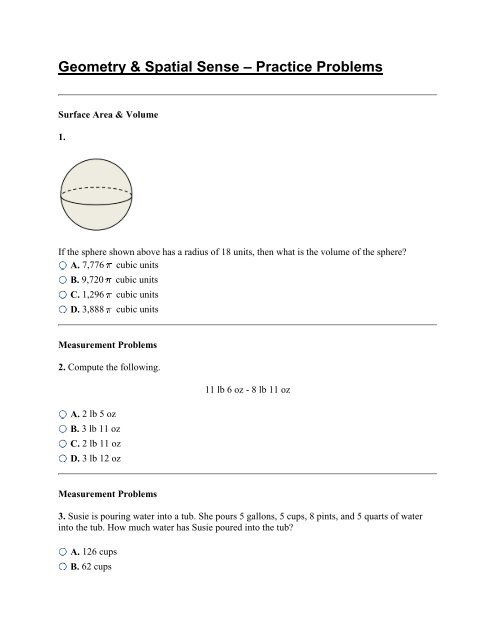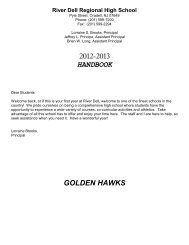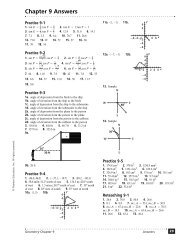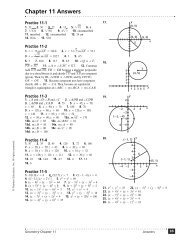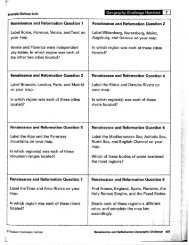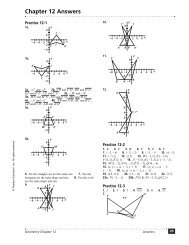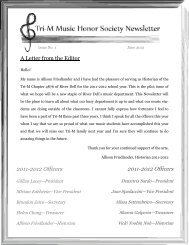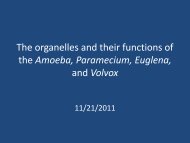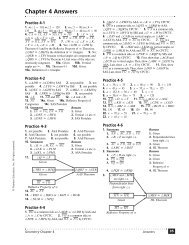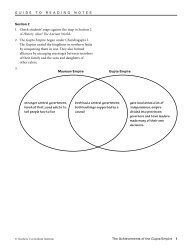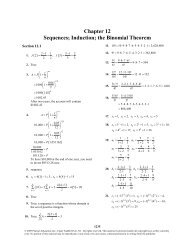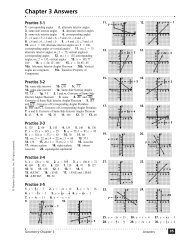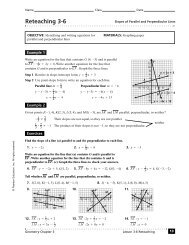Geometry & Spatial Sense â Practice Problems
Geometry & Spatial Sense â Practice Problems
Geometry & Spatial Sense â Practice Problems
Create successful ePaper yourself
Turn your PDF publications into a flip-book with our unique Google optimized e-Paper software.
<strong>Geometry</strong> & <strong>Spatial</strong> <strong>Sense</strong> – <strong>Practice</strong> <strong>Problems</strong><br />
Surface Area & Volume<br />
1.<br />
If the sphere shown above has a radius of 18 units, then what is the volume of the sphere?<br />
A. 7,776 cubic units<br />
B. 9,720 cubic units<br />
C. 1,296 cubic units<br />
D. 3,888 cubic units<br />
Measurement <strong>Problems</strong><br />
2. Compute the following.<br />
11 lb 6 oz - 8 lb 11 oz<br />
A. 2 lb 5 oz<br />
B. 3 lb 11 oz<br />
C. 2 lb 11 oz<br />
D. 3 lb 12 oz<br />
Measurement <strong>Problems</strong><br />
3. Susie is pouring water into a tub. She pours 5 gallons, 5 cups, 8 pints, and 5 quarts of water<br />
into the tub. How much water has Susie poured into the tub?<br />
A. 126 cups<br />
B. 62 cups
C. 81 cups<br />
D. 121 cups<br />
Similar Figures<br />
4. Amanda is resizing a rectangular picture on her computer. The original picture has a width of<br />
8 in and a length of 5 in. If she wants to keep it proportional, but have the new width be 4 in,<br />
what should be the new length?<br />
A. 10.0 in<br />
B. 2.0 in<br />
C. 7.5 in<br />
D. 2.5 in<br />
Properties of Polygons<br />
5. Find the measure of one interior angle of a regular polygon with nine sides.<br />
A. 280°<br />
B. 70°<br />
C. 1,260°<br />
D. 140°<br />
Geometric Patterns<br />
6.<br />
Look at Koch's Snowflake above. What would it look like after one more iteration?<br />
W. X.
Y. Z.<br />
A. Y<br />
B. W<br />
C. Z<br />
D. X<br />
Surface Area & Volume<br />
7.<br />
If X = 4 units, then what is the volume of the cube shown above?<br />
A. 128 cubic units<br />
B. 36 cubic units<br />
C. 64 cubic units<br />
D. 39 cubic units<br />
Pythagorean Theorem<br />
8.<br />
*Note: Figure not drawn to scale.<br />
If Y = 5 cm and Z = 13 cm, what is the length of X?<br />
A. 12 cm
B. 9 cm<br />
C. 13 cm<br />
D. 11 cm<br />
Object Transformations<br />
9. Which of the following transformations will produce a figure that is similar, but not congruent,<br />
to the original figure?<br />
A. dilation<br />
B. reflection<br />
C. translation<br />
D. rotation<br />
Nets & Projective Views<br />
10. Which of the four nets shown below can be folded into a triangular prism?<br />
W. X.<br />
Y. Z.<br />
A. Z<br />
B. Y<br />
C. X<br />
D. W<br />
Geometric Patterns
11. Which of the following shapes show self-similarity?<br />
W. X.<br />
Y. Z.<br />
A. X and Y<br />
B. X and Z<br />
C. X, Y, and Z<br />
D. W and X<br />
Geometric Patterns<br />
12.<br />
An oval-shaped pink bead is inserted next to each circle-shaped aqua bead in the necklace. Using<br />
this new pattern, if a necklace is made with 120 beads, how many pattern segments will the<br />
necklace have?<br />
A. 21 with 4 left over<br />
B. 20 with 2 left over<br />
C. 20<br />
D. 17
Object Transformations<br />
13.<br />
The translation above shows an object moving ______________.<br />
A. 8 units to the right and 3 units down<br />
B. 8 units to the right and 2 units down<br />
C. 9 units to the right and 3 units down<br />
D. 9 units to the right and 2 units down<br />
Properties of Polygons<br />
14. What is the main difference between a square and a rhombus?<br />
A. A square has sides that are parallel, but a rhombus does not.<br />
B. A rhombus is always bigger than a square.<br />
C. A rhombus has 4 right angles, but a square does not.<br />
D. A square must have 4 right angles, but a rhombus may or may not.<br />
Pythagorean Theorem<br />
15.<br />
Is S = 7 cm and T = 24, what is the length of R?
31 cm<br />
A.<br />
28 cm<br />
B.<br />
23 cm<br />
C.<br />
25 cm<br />
D.<br />
Geometric Patterns<br />
16. Determine the number of iterations that created the Koch's Snowflake below.<br />
A. 2<br />
B. 3<br />
C. 1<br />
D. 4<br />
Geometric Patterns<br />
17.<br />
In the pattern sequence above there are five shapes. If this pattern is repeated for a total of 64<br />
shapes, what would be the final shape?<br />
A. hexagon<br />
B. square<br />
C. diamond<br />
D. octagon
Properties of Polygons<br />
18. Find the measure of one interior angle of a regular octagon.<br />
A. 270°<br />
B. 1,080°<br />
C. 135°<br />
D. 180°<br />
Perimeter & Area<br />
19.<br />
Note: Figure not drawn to scale.<br />
If X = 7 units, Y = 13 units, and Z = 14 units, then what is the perimeter of the triangle shown<br />
above?<br />
A. 28 units<br />
B. 33 units<br />
C. 30 units<br />
D. 34 units<br />
Similar Figures<br />
20.
Note: Figures are not drawn to scale.<br />
Right triangle ABC is similar to right triangle DEF. If the measure of angle A is 33°, what is the<br />
measure of angle F?<br />
A. 147°<br />
B. 57°<br />
C. 33°<br />
D. 89°<br />
Similar Figures<br />
21.<br />
Note: Figures not drawn to scale.<br />
In the picture above, KLMN ~ XYZW. If K = 8 m, L = 5 m, M = 7 m,<br />
N = 13 m, and Z = 10.5 m, then what is the length of Y?<br />
A. 19.5 m<br />
B. 7.5 m<br />
C. 12 m<br />
D. 13.5 m<br />
Geometric Patterns<br />
22. At each iteration in the Sierpinski Triangle, the area of the original is changed by how much?<br />
The first 3 iterations of Sierpinski's Triangle look like this:
A. increased by 75%<br />
B. reduced by 50%<br />
C. reduced by 25%<br />
D. increased by 25%<br />
Similar Figures<br />
23.<br />
Note: Figure is not drawn to scale.<br />
The rectangle above has the dimensions 31 cm by 19 cm.<br />
Which set of dimensions would produce a similar figure?<br />
A. 31 cm by 95 cm<br />
B. 165 cm by 95 cm<br />
C. 155 cm by 19 cm<br />
D. 155 cm by 95 cm<br />
Pythagorean Theorem<br />
24. The city of Nairobi, Kenya, is 470 km east and 185 km south of the city of Kampala,<br />
Uganda. If Matunde is flying from Nairobi to Kampala, what is the shortest possible distance of<br />
his flight? (Round to the nearest km.)<br />
A. 505 km<br />
B. 432 km<br />
C. 655 km<br />
D. 563 km
Perimeter & Area<br />
25. A cylinder with a radius of 6 in, a height of 15 in, and its cross section are shown below.<br />
Note: Figure not drawn to scale.<br />
What is the area of the cross section shown?<br />
A.<br />
B.<br />
C.<br />
D.<br />
Geometric Patterns<br />
26. The Iterated Function System (IFS)<br />
A. is the result of geometric calculations.<br />
B. includes a system to determine the area of a geometric figure.<br />
C. is the means to stop geometric patterns from growing.<br />
D.<br />
involves a simple transformation done to an object or shape that is repeatedly done on<br />
resulting object or shape.<br />
Perimeter & Area<br />
27.
What is the approximate area of the figure above?<br />
A. 12<br />
B. 8 1 / 2<br />
C. 15 1 / 2<br />
D. 10<br />
Properties of Polygons<br />
28. The vertices of a quadrilateral are located at (0, -2), (5, -2), (5, 6), and (0, 6).<br />
Which of the following classifies this quadrilateral?<br />
A. The quadrilateral is a square.<br />
B. The quadrilateral is a trapezoid.<br />
C. The quadrilateral is a rhombus.<br />
D. The quadrilateral is a rectangle.<br />
Nets & Projective Views<br />
29. A 2-dimensional net is shown below.<br />
Which of the following 3-dimensional shapes can be formed with this net?<br />
A. rectangle<br />
B. circle<br />
C. cylinder
D. cone<br />
Surface Area & Volume<br />
30.<br />
If the volume of the smaller cylinder is 36 in 3 , what is the volume of the larger cylinder?<br />
(Volume = r 2 h)<br />
A. 108 in 3<br />
B. 72 in 3<br />
C. 144 in 3<br />
D. 180 in 3<br />
Perimeter & Area<br />
31.<br />
16 units<br />
9 units<br />
What is the perimeter of the rectangle above?<br />
A. 59 units<br />
B. 25 units<br />
C. 144 units<br />
D. 50 units
Perimeter & Area<br />
32.<br />
If the area of the smaller rectangle is 30 inches 2 , what is the area of the larger rectangle?<br />
A. 120 inches 2<br />
B. 90 inches 2<br />
C. 60 inches 2<br />
D. 240 inches 2<br />
Measurement <strong>Problems</strong><br />
33. Compute the following.<br />
4.997 kL - 5,396 cL<br />
A. 399 cL<br />
B. 5,391.003 cL<br />
C. 494,304 cL<br />
D. 4,896.3 cL<br />
Pythagorean Theorem<br />
34.<br />
*Note: Figure not drawn to scale.
If Y = 8 ft and Z = 100 ft, what is the length of X?<br />
A. 28 ft<br />
B. 5 ft<br />
C. 136 ft<br />
D. 6 ft<br />
Pythagorean Theorem<br />
35.<br />
*Note: Figure not drawn to scale.<br />
If X = 9 cm and Y = 12 cm, what is the length of Z?<br />
A. 15 cm<br />
B. 13 cm<br />
C. 14 cm<br />
D. 18 cm<br />
Surface Area & Volume<br />
36.<br />
Note: Figure not drawn to scale<br />
If h = 15 units and r = 5 units, what is the volume of the cone shown above? Use 3.14 for .
A. 78.5 cubic units<br />
B. 235.5 cubic units<br />
C. 392.5 cubic units<br />
D. 1,177.5 cubic units<br />
Surface Area & Volume<br />
37.<br />
Note: Figure not drawn to scale<br />
If l = 9 units, w = 8 units, and h = 17 units, what is the surface area of the rectangular prism<br />
shown above?<br />
A. 790 square units<br />
B. 1,224 square units<br />
C. 361 square units<br />
D. 722 square units<br />
Similar Figures<br />
38. Rectangle ABDE and rectangle CDEF are similar.<br />
What is the length of AE?<br />
A.
B.<br />
C.<br />
D.<br />
Perimeter & Area<br />
39.<br />
If the area of the smaller circle is 4 inches 2 , what is the area of the larger circle?<br />
A. 8 inches 2<br />
B. 12 inches 2<br />
C. 16 inches 2<br />
D. 24 inches 2<br />
Geometric Patterns<br />
40.<br />
A necklace contains 100 beads. A section of it is shown above. If the pattern shown continues to<br />
repeat itself in the necklace, how many circle-shaped aqua beads are in the necklace?<br />
A. 90<br />
B. 95<br />
C. 19
D. 20<br />
Object Transformations<br />
41.<br />
Which graph shows a reflection across the x-axis?<br />
A. IV<br />
B. III<br />
C. II<br />
D. I<br />
Nets & Projective Views<br />
42.<br />
Which solid is represented by the top, front, and side views above?
A. Z<br />
B. W<br />
C. Y<br />
D. X<br />
Measurement <strong>Problems</strong><br />
43. Paul is measuring pieces of wood in order to build a shelf. The first piece of wood measured<br />
4 feet and 7 inches. The second piece of wood measures 2 feet and 5 inches. The third piece of<br />
wood measures 2 feet and 8 inches. How much wood does Paul have altogether?<br />
A. 9 feet 8 inches<br />
B. 28 feet<br />
C. 11 feet 2 inches<br />
D. 7 feet 8 inches<br />
Object Transformations<br />
44.<br />
Lisa is drawing triangle STU that is a dilation from point (6,5) of triangle PQR. She has already<br />
drawn points S and T.
At what coordinates should she plot point U, of triangle STU?<br />
A. (6,-1)<br />
B. (6,1)<br />
C. (-3,-1)<br />
D. (6,-4)<br />
Measurement <strong>Problems</strong><br />
45. Jody juggled for 4 days and 6 hours. How many minutes did Jody juggle?<br />
A. 420 minutes<br />
B. 4.6 minutes<br />
C. 6,120 minutes<br />
D. 10 minutes<br />
Pythagorean Theorem<br />
46. Anthony was mapping out a route to ride his bike. The route he picked forms a right triangle,<br />
as shown in the picture below.<br />
If the route takes him 5 miles on Forrest Lane and 13 miles up Cedar Drive, how far will<br />
Anthony ride down Pine Avenue?<br />
A. 18 miles<br />
B. 8 miles<br />
C. 12 miles<br />
D. 15 miles<br />
Nets & Projective Views
47.<br />
Which solid is represented by the front, side, and top views above?<br />
A. Y<br />
B. X<br />
C. W<br />
D. Z<br />
Perimeter & Area<br />
48.<br />
Note: Figure not drawn to scale.<br />
If X = 13 units and h = 7 units, then what is the area of the triangle shown above?<br />
A. 182 square units<br />
B. 24.5 square units
C. 45.5 square units<br />
D. 91 square units<br />
Object Transformations<br />
49.<br />
Which graph below shows a rotation of the object in the graph above about point (-2, 3)?<br />
A. II<br />
B. IV<br />
C. I<br />
D. III<br />
Similar Figures<br />
50.
Note: Figure is not drawn to scale.<br />
The rectangle above has the dimensions 11 yd by 34 yd.<br />
Which set of dimensions would produce a similar figure?<br />
A. 87 yd by 238 yd<br />
B. 11 yd by 238 yd<br />
C. 77 yd by 34 yd<br />
D. 77 yd by 238 yd<br />
Measurement <strong>Problems</strong><br />
51. Compute the following.<br />
77.8 mg + 0.781 kg<br />
A. 78.581 g<br />
B. 78,581 g<br />
C. 78.878 g<br />
D. 781.0778 g<br />
Properties of Polygons<br />
52. Which of the following is a quadrilateral that will always have 4 equal sides and 4 right<br />
angles?<br />
A. rectangle<br />
B. trapezoid<br />
C. rhombus<br />
D. square<br />
Pythagorean Theorem
53. Find the area of the right triangle pictured below.<br />
*triangle not drawn to scale<br />
12 in<br />
11 in<br />
A. 5.5 in 2<br />
B. 52.75 in 2<br />
C. 26.38 in 2<br />
D. 89.53 in 2<br />
Surface Area & Volume<br />
54.<br />
Note: Figure not drawn to scale<br />
If l = 13 units, w = 8 units, and h = 4 units, what is the volume of the rectangular prism shown<br />
above?<br />
A. 832 cubic units<br />
B. 416 cubic units<br />
C. 376 cubic units<br />
D. 208 cubic units<br />
Surface Area & Volume<br />
55.
Note: Figure is not drawn to scale<br />
If x = 5 units, y = 6 units, z = 9 units, and h = 4 units, then what is the surface area of the<br />
triangular prism shown above?<br />
A. 168 units 2<br />
B. 192 units 2<br />
C. 96 units 2<br />
D. 105 units 2<br />
Perimeter & Area<br />
56.<br />
4 units<br />
What is the area of the rectangle above?<br />
A. 20 square units<br />
B. 64 square units<br />
C. 40 square units<br />
D. 80 square units<br />
16 units<br />
Geometric Patterns<br />
57. Which of the following shapes show self-similarity?
W. X.<br />
Y. Z.<br />
A. W, X, and Y<br />
B. Y and Z<br />
C. X, Y, and Z<br />
D. X and Z<br />
Similar Figures<br />
58.<br />
Note: Figures are not drawn to scale.<br />
Triangles ABC and DEF are similar figures. If the length of side AC is 14 units, the length of<br />
side BC is 8 units, and the length of side DF is 126 units, what is the length of side EF?<br />
A. 63 units<br />
B. 80 units<br />
C. need more information<br />
D. 72 units<br />
Similar Figures
59.<br />
Note: Figures not drawn to scale.<br />
In the picture above, KLMN ~ XYZW. If m K = 140°, m L = 109°, m M = 56°,<br />
and m N = 55°, then what is the measure of W?<br />
A. 109°<br />
B. 56°<br />
C. 132°<br />
D. 55°<br />
Perimeter & Area<br />
60. The diagram shows isosceles triangle STU. Each vertex of triangle STU is a point on circle V.<br />
If the area of circle V is<br />
sq units, what is the area of triangle STU?<br />
A.<br />
B.<br />
C.<br />
D.
Pythagorean Theorem<br />
61.<br />
*Note: Figure not drawn to scale.<br />
If X = 5 cm and Y = 12 cm, what is the length of Z?<br />
A. 13 cm<br />
B. 12 cm<br />
C. 10 cm<br />
D. 11 cm<br />
Nets & Projective Views<br />
62.<br />
The pictures above represent the front and side views of which of the objects below?<br />
W. X. Y. Z.<br />
A. X
B. Y<br />
C. W<br />
D. Z<br />
Similar Figures<br />
63.<br />
Note: Figures not drawn to scale.<br />
In the picture above, PQRST ~ VZYXW. If m P = 95°, m Q = 78°, m R = 224°, m S<br />
= 36°, and m T = 107°, then what is the measure of W?<br />
A. 224°<br />
B. 107°<br />
C. 78°<br />
D. 36°<br />
Pythagorean Theorem<br />
64. Find the perimeter of the right triangle pictured below.<br />
*triangle not drawn to scale<br />
7 cm<br />
25 cm<br />
A. 56 cm<br />
B. 26 cm<br />
C. 58 cm<br />
D. 84 cm<br />
Surface Area & Volume
65.<br />
Note: Figures are not drawn to scale<br />
The pyramid and prism above have the same L, W, and H. The volume of the pyramid is 18 cm 3 .<br />
What is the volume of the prism?<br />
A. 36 cm 3<br />
B. 6 cm 3<br />
C. 12 cm 3<br />
D. 54 cm 3<br />
Properties of Polygons<br />
66. Alan is building a sign to put in front of his office building.<br />
The sign has 6 sides.<br />
The sign has 3 diagonals coming from each vertex.<br />
The sum of the sign's interior angles equals 720°.<br />
What shape is Alan's sign?<br />
A. octagon<br />
B. hexagon<br />
C. pentagon<br />
D. rectangle<br />
Object Transformations<br />
67.
Which of the following describes the transformations performed on the object shown above?<br />
The object was reflected across the x-axis and shifted 7 units in the x direction and -5 units<br />
A. in the y direction.<br />
B.<br />
C.<br />
D.<br />
The object was reflected across the y-axis and shifted 1 unit in the x direction and -7 units<br />
in the y direction.<br />
The object was reflected across the y-axis and shifted -1 unit in the x direction and -7 units<br />
in the y direction.<br />
The object was reflected across the x-axis and shifted 9 units in the x direction and -3 units<br />
in the y direction.<br />
Measurement <strong>Problems</strong><br />
68. Compute the following.<br />
5 ft 3 in + 7 ft 11 in<br />
A. 11 ft 8 in<br />
B. 12 ft 2 in<br />
C. 13 ft 8 in<br />
D. 13 ft 2 in<br />
Nets & Projective Views<br />
69.
W. X. Y. Z.<br />
Which of the objects above have the following front view?<br />
A. X, Y, and Z<br />
B. W and X<br />
C. X and Y<br />
D. W, X, and Y<br />
Properties of Polygons<br />
70. The vertices of a quadrilateral are located at (-3, 2), (1, 5), (5, 2), and (1, -1).<br />
Which of the following classifies this quadrilateral?<br />
A. The quadrilateral is a rectangle.<br />
B. The quadrilateral is a trapezoid.<br />
C. The quadrilateral is a rhombus.<br />
D. The quadrilateral is a square.<br />
Nets & Projective Views<br />
71. The drawing represents a 3-dimensional figure.<br />
Which of the following represent the left and front views of the figure?
W. X.<br />
Y. Z.<br />
A. Z<br />
B. X<br />
C. W<br />
D. Y<br />
Nets & Projective Views<br />
72.<br />
The pictures above represent the front, side, and top views of which of the objects below?<br />
A. Y<br />
W. X. Y. Z.
B. Z<br />
C. W<br />
D. X<br />
Nets & Projective Views<br />
73. Which of the four nets shown below can be formed into a cone?<br />
W. X. Y. Z.<br />
A. X<br />
B. Y<br />
C. Z<br />
D. W<br />
Surface Area & Volume<br />
74.<br />
Note: Figure is not drawn to scale.<br />
If x = 5 units and y = 9 units, then what is the volume of the square pyramid shown above?<br />
A. 150 cubic units<br />
B. 225 cubic units<br />
C. 75 cubic units<br />
D. 125 cubic units<br />
Similar Figures<br />
75.
Note: Figure is not drawn to scale.<br />
The triangle above has side lengths of 30 mm and 38 mm.<br />
Which set of dimensions would produce a similar figure?<br />
A. 150 mm, 195 mm<br />
B. 150 mm, 5 mm<br />
C. 150 mm, 190 mm<br />
D. 150 mm, 38 mm<br />
Properties of Polygons<br />
76.<br />
Which of the following shapes is shown above?<br />
A. square<br />
B. rectangle<br />
C. trapezoid<br />
D. parallelogram<br />
Nets & Projective Views<br />
77.
Which of the following set of pictures represents a side and the bottom view of this solid?<br />
A.<br />
B.<br />
C.<br />
D.<br />
Similar Figures<br />
78.<br />
Note: Figures are not drawn to scale.<br />
Rectangles ABCD and EFGH are similar figures because angles A, B, C, and D are congruent to<br />
angles E, F, G, and H, respectively.<br />
If DA equals 16 units, AB equals 7 units, and HE equals 112 units, what does EF equal?<br />
A. 7 units<br />
B. 256 units<br />
C. 103 units<br />
D. 49 units<br />
Nets & Projective Views<br />
79. Which of the four nets shown below can be folded into a triangular prism?
W. X.<br />
Y. Z.<br />
A. Z<br />
B. Y<br />
C. W<br />
D. X<br />
Properties of Polygons<br />
80. Find the measure of one interior angle of a regular pentagon.<br />
A. 540°<br />
B. 108°<br />
C. 90°<br />
D. 27°<br />
Measurement <strong>Problems</strong><br />
81. Billy and his sister, Sarah, are competing to see who can throw their football the farthest.<br />
Billy threw the football 32 yards. Sarah threw the football 1,136 inches. How much farther than<br />
Sarah did Billy throw the football?<br />
A. 97.6 inches<br />
B. 23 inches<br />
C. 16 inches
D. 20 inches<br />
Surface Area & Volume<br />
82.<br />
Note: Figure not drawn to scale.<br />
Heights (Y and Z) have been rounded for computational ease.<br />
If X = 4 units, Y = 3.5 units, and Z = 3.5 units, then what is the surface area of the right<br />
triangular pyramid shown above?<br />
A. 28 square units<br />
B. 49 square units<br />
C. 36 square units<br />
D. 64 square units<br />
Properties of Polygons<br />
83.<br />
Find the sum of the interior angles of the polygon shown above.<br />
A. 540°<br />
B. 720°<br />
C. 900°<br />
D. 360°<br />
Properties of Polygons
84. The interior angles of a polygon equal 180°. How many sides does this polygon have?<br />
A. 2<br />
B. 4<br />
C. 3<br />
D. 5<br />
Geometric Patterns<br />
85.<br />
If the 7-bead segment above is repeated several times to create a necklace with 70 beads, how<br />
many oval-shaped beads will the necklace have?<br />
A. 10<br />
B. 30<br />
C. 18<br />
D. 20<br />
Object Transformations<br />
86.<br />
The translation above shows the object moving ______________.<br />
A. 6 units to the left and 5 units up
B. 3 units to the left and 8 units up<br />
C. 3 units to the right and 8 units down<br />
D. 8 units to the right and 3 units down<br />
Perimeter & Area<br />
87.<br />
7 in.<br />
What is the circumference of the circle?<br />
A. 21.98 in<br />
B. 153.86 in<br />
C. 43.96 in<br />
D. 87.92 in<br />
Measurement <strong>Problems</strong><br />
88. Compute the following.<br />
67.6 cm + 81 mm<br />
A. 75.16 cm<br />
B. 87.76 cm<br />
C. 148.6 cm<br />
D. 75.7 cm<br />
Surface Area & Volume<br />
89.
Note: Figure not drawn to scale.<br />
If W = 40 units, X = 28 units, Y = 50 units, and Z = 52 units, then what is the surface area of the<br />
right rectangular pyramid shown above?<br />
A. 4,576 units 2<br />
B. 8,032 units 2<br />
C. 2,848 units 2<br />
D. 3,456 units 2<br />
Geometric Patterns<br />
90.<br />
In the pattern above, how many blue dots will the diagram have in position 2?<br />
A. 2<br />
B. 3<br />
C. 5<br />
D. 4<br />
Object Transformations<br />
91.
If the figure above was rotated 180° counter-clockwise about point A, where would point B on<br />
the figure be plotted?<br />
A. (0,-3)<br />
B. (1,6)<br />
C. (2,-3)<br />
D. (6,2)<br />
E. (6,1)<br />
Object Transformations<br />
92. Which of the following transformations will always produce a congruent figure?<br />
A. translation<br />
B. enlargement<br />
C. dilation<br />
D. reduction<br />
Object Transformations<br />
93.<br />
The translation above shows an object moving ______________.
A. 5 units to the left and 7 units up<br />
B. 7 units to the right and 5 units down<br />
C. 5 units to the left and 7 units down<br />
D. 5 units to the right and 7 units up<br />
Pythagorean Theorem<br />
94. The figure shows some of the dimensions of a parallelogram.<br />
Note: Figure not drawn to scale<br />
What is h, the height of the parallelogram?<br />
A. 17 cm<br />
B. 24 cm<br />
C. 12 cm<br />
D. 6 cm<br />
Perimeter & Area<br />
95.<br />
What is the approximate area of the figure above?<br />
A. 11<br />
B. 12 1 / 2
C. 8<br />
D. 9<br />
Measurement <strong>Problems</strong><br />
96. Compute the following.<br />
2 c 5 fl oz + 5 c 6 fl oz<br />
A. 8 c 7 fl oz<br />
B. 7 c 3 fl oz<br />
C. 8 c 3 fl oz<br />
D. 8 c 9 fl oz<br />
Object Transformations<br />
97. Parallelogram JKLM has the coordinates J (1, 8), K (11, 8), L (10, 2), and M (0, 2). Which of<br />
the following sets of points represents a dilation from the origin of parallelogram JKLM?<br />
A. J' (4, 8), K' (44, 8), L' (40, 2), M' (0, 2)<br />
B. J' (5, 12), K' (15, 12), L' (14, 6), M' (4, 6)<br />
C. J' (4, 32), K' (44, 32), L' (40, 8), M' (0, 8)<br />
D. J' (1, 32), K' (44, 8), L' (40, 2), M' (0, 8)<br />
Pythagorean Theorem<br />
98. Benton has an extension ladder than can only be used at a length of 10 feet, 15 feet, or 20<br />
feet. He places the base of the ladder 9 feet from the wall and needs the top of the ladder to reach<br />
12 feet. Which ladder length would Benton need to use to reach this height on the wall?<br />
A. 10 feet<br />
B. 15 feet<br />
C. 20 feet<br />
D. None of these ladder lengths would reach this height.<br />
Measurement <strong>Problems</strong>
99. A diver has 2,000 psi (pounds per square inch) in his dive tank at the beginning of a dive.<br />
The end reading was 1,000 psi after a dive time of 15 minutes. At what rate was the pressure in<br />
the dive tank decreasing?<br />
A. 66.67 psi/min<br />
B. 133.33 psi/min<br />
C. 200 psi/min<br />
D. |Round(10000*(a+c+e)/(b+d+d+1))/100| miles per hour<br />
Pythagorean Theorem<br />
100.<br />
If L = 65 cm and J = 33 cm, what is the length of K?<br />
56 cm<br />
A.<br />
55 cm<br />
B.<br />
65 cm<br />
C.<br />
73 cm<br />
D.<br />
Answers<br />
1. A<br />
2. C<br />
3. D<br />
4. D<br />
5. D<br />
6. C<br />
7. C
8. A<br />
9. A<br />
10. B<br />
11. A<br />
12. C<br />
13. D<br />
14. D<br />
15. D<br />
16. C<br />
17. D<br />
18. C<br />
19. D<br />
20. B<br />
21. B<br />
22. C<br />
23. D<br />
24. A<br />
25. A<br />
26. D<br />
27. A<br />
28. D<br />
29. C<br />
30. C<br />
31. D<br />
32. A<br />
33. C<br />
34. D<br />
35. A<br />
36. C<br />
37. D<br />
38. C<br />
39. C<br />
40. D<br />
41. D<br />
42. D<br />
43. A<br />
44. A<br />
45. C<br />
46. C<br />
47. D<br />
48. C<br />
49. B<br />
50. D<br />
51. D<br />
52. D<br />
53. C
54. B<br />
55. A<br />
56. B<br />
57. B<br />
58. D<br />
59. D<br />
60. A<br />
61. A<br />
62. A<br />
63. B<br />
64. A<br />
65. D<br />
66. B<br />
67. C<br />
68. D<br />
69. D<br />
70. C<br />
71. A<br />
72. C<br />
73. C<br />
74. C<br />
75. C<br />
76. D<br />
77. D<br />
78. D<br />
79. D<br />
80. B<br />
81. C<br />
82. A<br />
83. A<br />
84. C<br />
85. D<br />
86. B<br />
87. C<br />
88. D<br />
89. A<br />
90. B<br />
91. E<br />
92. A<br />
93. A<br />
94. C<br />
95. A<br />
96. C<br />
97. C<br />
98. B
99. A<br />
100. A


